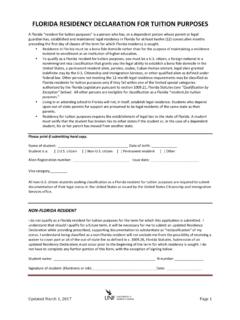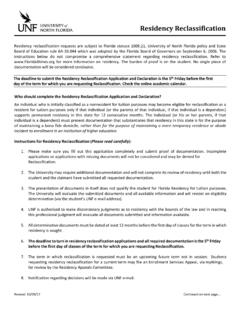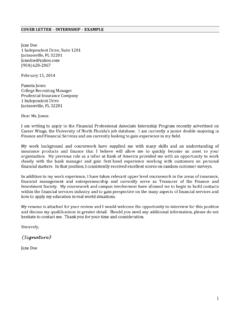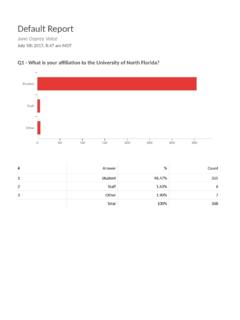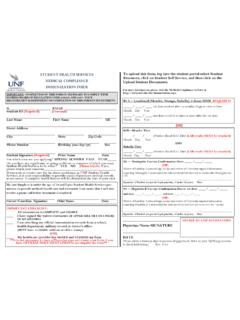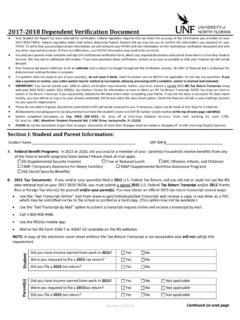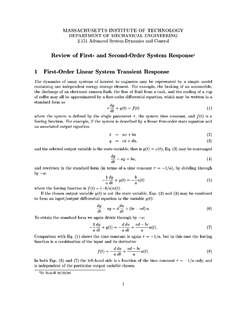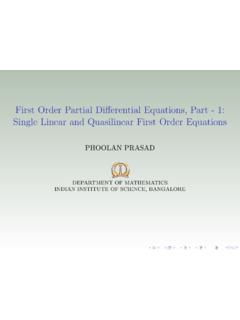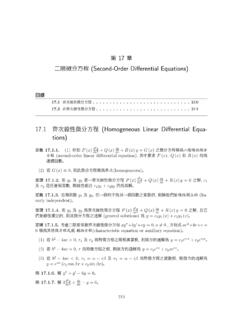Transcription of System of First Order Differential Equations
1 CHAPTER 1 System of First Order Differential EquationsIn this chapter, we will discuss System of First Order differential equa-tions. There are many applications that involving find several unknownfunctions simultaneously . Those unknown functions are related by aset of Equations that involving the unknown functions and their firstderivatives. For example, in Chapter Two, we studied the epidemic ofcontagious diseases. Now if S(t) denotes number of people that is susceptible to the diseasebut not infected yet. I(t) denotes number of people actually infected. R(t) denotes the number of people have we assume The fraction of the susceptible who becomes infected per unittime is proportional to the number infected,bis the propor-tional number. A fixed fractionrSof the infected population recovers per unittime, 0 r 1. A fixed fraction of the recoversgbecome susceptible and in-fected, 0 g 1.
2 Proportional System of differential Equations model this phenomena areS = bIS+gRI =bIS rIR =rI gRThe numbers of unknown function in a System of differential equa-tions can be arbitrarily large, but we will concentrate ourselves on 2 to3 unknown Principle of superpositionLetaij(t), bj(t)i= 1,2, , nandj= 1,2, , nbe knownfunction, andxit, i= 1,2, , nbe unknown functions, the linear first121. System OF First Order DIFFERENTIAL Equations Order System of differential equation forxi(t) is the following,x 1(t) =a11(t)x1(t) +a12(t)x2(t) + +a1n(t)xn(t) +b1(t)x 2(t) =a21(t)x1(t) +a22(t)x2(t) + +a2n(t)xn(t) +b2(t)x 3(t) =a31(t)x1(t) +a32(t)x2(t) + +a3n(t)xn(t) +b3(t)..x n(t) =an1(t)x1(t) +an2(t)x2(t) + +ann(t)xn(t) +f1(t)Letx(t) be the column vector of unknown functionsxit, i=1,2, , n,A(t) = (aij(t),andb(t) be the column vector of knownfunctionsbit, i= 1,2, , n,we can write the First Order System ofequations asx (t) =A(t)x(t) +b(t)(1) Whenn= 2, the linear First Order System of Equations for twounknown functions in matrix form is,[x 1(t)x 2(t)]=[a11(t)a12(t)a21(t)a22(t)][x1(t)x2 (t)]+[b1(t)b2(t)] Whenn= 3, the linear First Order System of Equations forthree unknown functions in matrix form is, x 1(t)x 2(t)x 3(t) = a11(t)a12(t)a13a21(t)a22(t)a23a31(t)a32( t)a33 x1(t)x2(t)x3t + b1(t)b2(t)b3(t) Asolutionof equation (1) on the open intervalIis a column vec-tor functionx(t) whose derivative (as a vector-values function) equalsA(t)x(t) +b(t).)
3 The following theorem gives existence and uniquenessof solutions, the vector-valued functionsA(t)andb(t)are con-tinuous over an open intervalIcontainst0,then the initial value prob-lem{x (t) =A(t)x(t) +b(t)x(t0) =x0has an unique vector-values solutionx(t)that is defined on entire in-tervalIfor any given initial (t) 0,the linear First Order System of Equations becomesx (t) =A(t)x(t),which is called ahomogeneous in the case of one equation, we want to find out the generalsolutions for the linear First Order System of Equations . To this end, wefirst have the following results for the homogeneous equation,1. PRINCIPLE OF of SuperpositionLetx1(t), bx2(t), ,xn(t)bensolutions of the homogeneous linear equationx (t) =A(t)x(t)on the open , c2, , cnarenconstants, then thelinear combinationc1x1(t) +c2x2(t) +c3x3(t) + +cnxn(t)is also a solution (t) =[1 00 2]x(t),x1(t) =[et0]andx2(t) =[0e 2t]are two solutions, asbx 1(t) =[(et) 0]=[et0]=[1 00 2][et0]andbx 2(t) =[0(e 2t) ]=[0 2e 2t]=[1 00 2][0e 2t]By the Principle of Superposition, for any two constantsc1andc2x(t) =c1x1(t) +c2x2(t) =c1[et0]+c2[0e 2t]=[c1etc2e 2t]is also solution.}
4 We shall see that it is actually the general next theorem gives the general solution of linear System ofequations, (t),x2(t), , bxn(t)benlinearly independent (as vectors)solution of the homogeneous systemx (t) =A(t)x(t),then for any solutionxc(t)there existsnconstantsc1, c2, , cnsuchthatxc(t) =c1x1(t) +c2x2(t) + +cnxn(t).We callxc(t)the general solution of the homogeneous System OF First Order DIFFERENTIAL EQUATIONSIfxp(t)is a particular solution of the nonhomogeneous System ,x(t) =B(t)x(t) +b(t),andxc(t)is the general solution to the associate homogeneous System ,x(t) =B(t)x(t)thenx(t) =xc(t) +xp(t)is the general (t) =[4 36 7]x(t) +[ 4t2+ 5t 6t2+ 7t+ 1]x(t),x1(t) =[3e2t2e2t]andx2(t) =[e 5t3e 5t]are two linearly independentsolutions. andxp(t) =[t2t]is a particular solution. By ,x(t) =c1x1(t) +c2x2(t) +xp(t) =[3c1e2t+ c2e 5t+ t22c1e2t+ 3c2e 5t+t](2)is the general solution.
5 Now suppose we want to find a particular so-lution that satisfies the initial conditionx(0) =[2 1],then lett= 0in (2), we havex(0) =[3c1+ c22c1+ 3c2]=[2 1],which can be written in matrix form,[3 12 3][c1c2]=[2 1],Solve this equation, we get[c1c2]=[1 1].So the particularsolution isx(t) =[3e2t e 5t+ t22e2t 3e 5t+t].From the above example, we can summarize the general steps infind a solution to initial value problem,{x (t) =A(t)x(t) +b(t)x(t0) =x02. homogeneous SYSTEM5 Step One:Find the general solutionxc=c1x1(t)+c2x2(t)+ +cnxn(t),wherex1(t),x2(t), ,xn(t) are a set of lin-early independent solutions, to the associate homogeneous sys-tem,x (t) =A(t)x(t). Step Two:Find a particular solutionxp(t)to the nonhomo-geneous System ,x (t) =A(t)x(t) +b(t). Step Three:Setx(t) =xc(t) +xp(t) and use the equationx(t0) =x0,to determinec1, c2, , homogeneous SystemWe will use a powerful method called eigenvalue method to solvethe homogeneous systemx (t) =Ax(t)whereAis a matrix with constant entry.}
6 We will present this methodforAis either a 2 2 or 3 3 cases. The method can be used forAis ann nmatrix. The idea is to find solutions of formx(t) =ve t,(3)a straight line that passing origin in the taking deriv-ative onx(t),we havex (t) = ve t(4)put (3) and ( ) into the homogeneous equation, we getx (t) = ve t=Ave tSoAv= v,which indicates that must be an eigenvalue ofAandvis an a2 [a11a12a21a22]Then the characteristic polynomialp( ) ofAisp( ) =|A I|= (a11 ) (a22 ) a12a21= 2 (a11+a22)+(a11a22 ( ) is a quadratic polynomial of .From Algebra, we know thatp( ) = 0 has either 2 distinct real solutions, or a double solution, or2 conjugate complex solutions. The following theorem summarize thesolution to the homogeneous System ,61. System OF First Order DIFFERENTIAL ( )be the characteristic polynomial ofA,forx (t) =Ax(t),Case 1:p( ) = 0has two distinct real solutions 1and [v11v21]andv2=[v12v22]are associate eigen-vector ( ,Av1= 1v1andAv2= 2v2) Then the generalsolution isxc(t) =c1v1e 1t+c2v2e 2tAnd (t) =[v11e 1tv12e 2tv21e 1tv22e 2t]is called thefundamental matrix(Afundamental matrixis a square matrix whose columns are linearly independent so-lutions of the homogeneous System ).)
7 Case 2:p( ) = 0has a double solutions this casep( ) = ( 0)2and 0is a zero ofp( )withmultiplicity 2.(1) 0has two linearly independent eigenvectors:Supposev1=[v11v21]andv2=[v1 2v22]are associate linearlyindependent eigenvectors. Then the general solution isxc(t) = (c1v1+c2v2)e 0tAnd (t) =e 0t[v11v12v21v22](2) 0has only one associate eigenvector:Supposev1=[v11v21]is the only associated eigenvector andv2=[v12v22]is a solution of( 0I A)v2= the general solution is,xc(t) = (c1v1+c2(tv1+v2)e 0tAnd (t) =e 0t[v11(v11t+v12)v21(v21t+v22)]is the fundamental solution homogeneous SYSTEM7 Case 3:p( ) = 0has two conjugate complex solutionsa+bianda [v11+ iv12v21+iv22]is the associate complex eigen-vector with respect toa+bi, then the general solution is,v1=[v11v21]andv2=[v12v22]xc(t) = [c1(v1cos(bt) v2sin(bt))c2(v2cos(bt) +v1sin(bt))] (t) =eat[v11cos(bt) v12sin(bt)v12cos(bt) +v11sin(bt)v21cos(bt) v22sin(bt)v22cos(bt) +v21sin(bt)]is the fundamental Theorem , let (t) be the fundamental matrix, the generalsolution is given byxc(t) = (t)c,withc=[c1c2]and the solutionthat satisfies a given initial conditionx(t0) =x0is given byx(t) = (t) (t0) distinct eigenvalues caseFind the generalsolution tox (t) =[2 3 1 5]x(t)SolutionUsing Mathcad , functionseigenvals()andeigen-vecs()In Mathcad , eigenvecs(M) Returns a matrix containing the eigenvectors.)
8 Thenth column of the matrix returned is an eigenvector corresponding to the ntheigenvalue returned by find, 1= 32+12 61 and 2= 32 12 61 with associated eigen-vectorsv1=[ 7 612]andv2=[ 7 + 612]respectively. Sothe fundamental matrix is (t) =[( 7 61)e( 32+12 61)t( 7 + 61)e( 32 12 61)t2e( 32+12 61)t2e( 32 12 61)t]and the general solution is, forc=[c1c2],xc(t) = (t)ca81. System OF First Order DIFFERENTIAL double eigenvalues with two linearly in-dependent eigenvectorsFind the general solution tox (t) =[2 00 2]x(t).SolutionThe eigenvalue is 0= 2 and associated eigenvectorsare[10]and[01],so the general solution isxc=[c1e2tc2e2t] double eigenvalues with only one eigen-vectorFind the solution tox (t) =[2 33 8]x(t)andx(0) =[23]SolutionUsing Mathcad , functionseigenvals()andeigen-vecs()we can find a double eigenvalue 0= 5 and eigenvector[.]
9 ].Notice, the symbolic operator (bring up by either [Shift][Ctrl][.] or[Ctrl][.]) will not work with eigenvecs() this time, but since multiplyan eigenvector by a nonzero constant still get an eigenvector, we canchoosev1=[3 3].To findwthat satisfies (A 0I)w=v1 0we will solve (A 0I)[w1w2]=[1 1].That is,[ 3 33 3][w1w2]=[3 3]One solution isw1= 1 andw2= 0So the fundamental matrix is (t) =e5t[ 3 3t+ 133t]and the general solution is,c=[c1c2],xc(t) = (t)cNow, (0) =e5(0)[ 3 3(0) + 133(0)]=[ 3 13 0]and (0)-1=13[0 1 3 3].Hence, the particular solution isx(t) = (t) (0)-1x0=e5t[ 3t + 43t 3]a2. homogeneous conjugate complex eigenvalues caseFindthe general solution tox (t) =[2 31 2]x(t)SolutionUsing Mathcad , functionseigenvals()andeigen-vecs()we find two conjugate complex eigenvalues, 1= 2 +i 3 and 2= 2 i 3 with associated eigenvectorv1=[ 3 i]with respect to 1.
10 Compare this with the Theorem , we havea= 2, b= 3, v11= 3, v21= 0, v12= 0,andv22= the fundamental matrix is (t) =e2t[ 3 cos(bt) sin(bt) 3 sin(bt) cos(bt)]and the general solution is,c=[c1c2],xc(t) = (t)c=e2t[ 3 cos( 3t) sin( 3t) 3 sin( 3t) cos( 3t)][c1c2]=e2t[ 3c1cos( 3t) c2sin( 3t) 3c1sin( 3t) c2cos( 3t)]Suppose we want to find a solution such thatx(0) =[12], thenx(t) = (t) (0)-1x(0)=e2t[ 3 cos( 3t) sin( 3t) 3 sin( 3t) cos( 3t)][ 3 00 1]-1[12]=e2t[ 3 cos( 3t) sin( 3t) 3 sin( 3t) cos( 3t)][1 3 2]=e2t[cos( 3t) + +2 sin( 3t) sin( 3t) + 2 cos( 3t)] a3 a11a12a13a21a22a23a31a32a33 Then the characteristic polynomialp( ) ofAgiven byp( ) =|A I|,101. System OF First Order DIFFERENTIAL EQUATIONSis a cubic polynomial of .From Algebra, we know thatp( ) = 0has either 3 distinct real solutions, or 2 distinct solutions and one is adouble solution, or one real solution and 2 conjugate complex solutions,or a triple solution.
